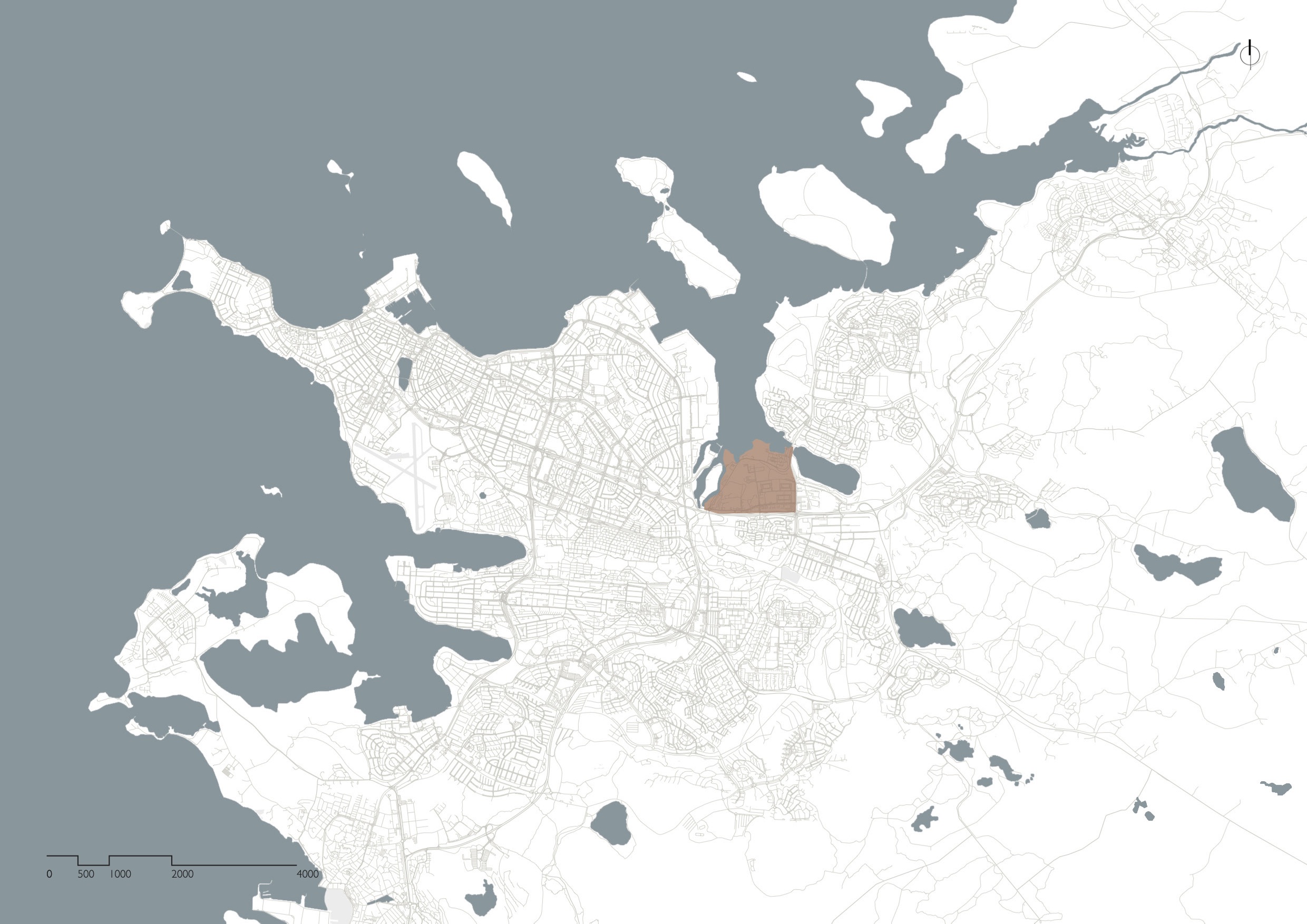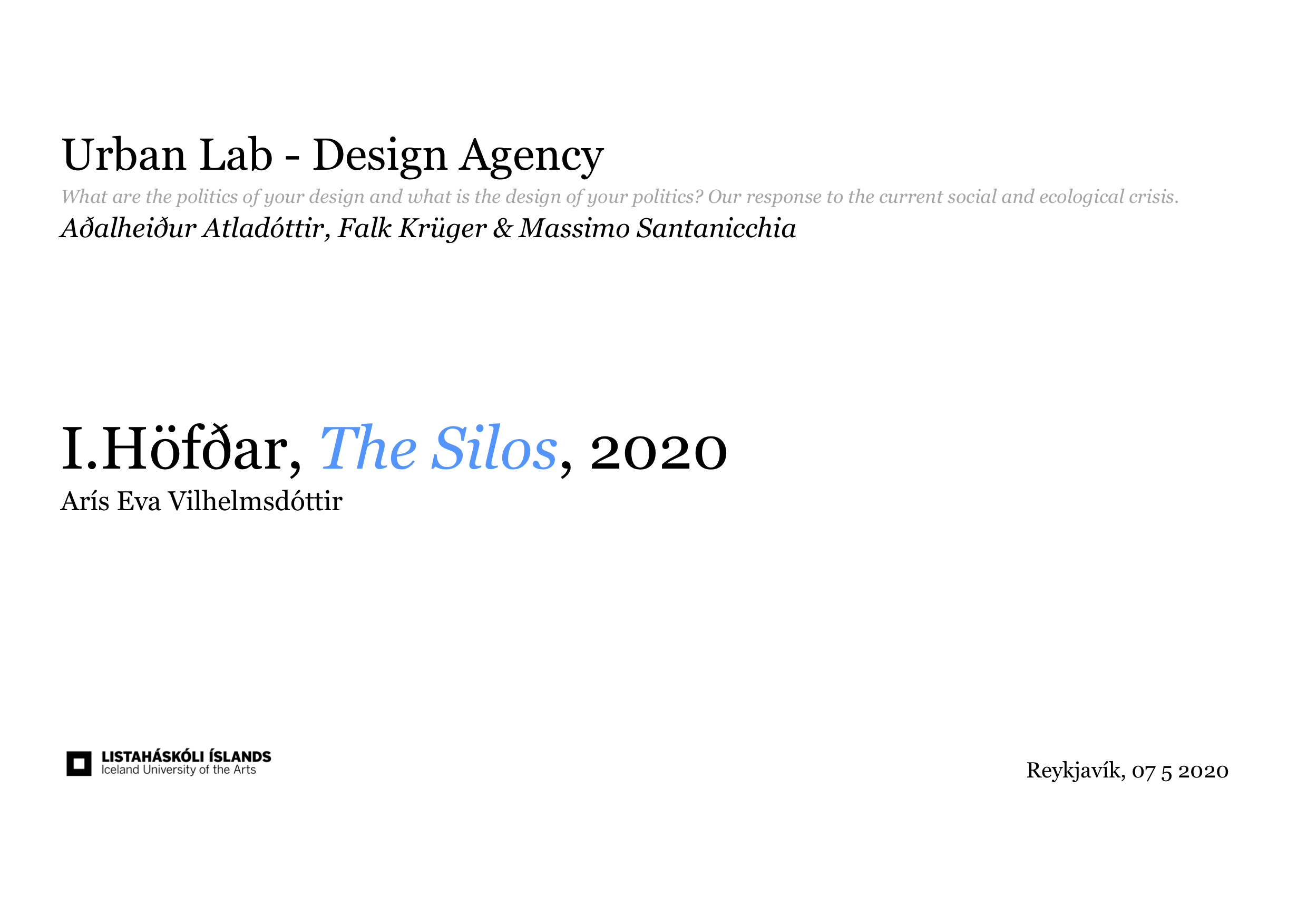II. Höfðar, The Silos, 2020
Judd’s high-walled bed
Arís Eva Vilhelmsdóttir — aris18 (at) lhi.is
The context of the design course Urban Lab - Design Agency for the academic year 2019-2020 is the area of Höfðar which is located in Reykjavik.

Map of Reykjavik with Höfðar in evidence
Höfðar hosts 2,751 inhabitants and more of 300 activities which altogether offer employment to thousands of people.

Map of Höfðar
54% of the surface of Höfðar is covered by water repellent materials which interfere with the natural water flow.

Water repellent surface in Höfðar
There are 8,764 parking lots in Höfðar which altogether cover a surface of 109,550 square metres.

Map of the parking places in Höfðar
By directly observing their usage it is discovered that on average only 50% of them is in use.

Map of the use of the parking places in Höfðar
These information tells us that a new plan for Höfðar must be envisioned one that is ecologically robust and socially vibrant.
In the Master Plan for 2030, Höfðar will be deeply tranformed: 6,200 new residential units will be built and ultimately support a population of over 15,000 inhabitants.

Proposed plan of Höfðar for 2030
This massive transformations give us the opportunity to designing Höfðar and reflecting upon contemporary urban living, to rethink the relationship among us and nature. A manifesto that embodies these intentions has been developed and it reads like this:
The Manifesto for Höfðar
Bigger context
When developing Höfði we should consider what purpose the area can serve in a bigger context. Reykjavík has been planned around the cars’ idea, which includes zoning and urban sprawl. This has created many problems both in urban planning as well societal. Höfði offers a good opportunity to reverse this development. The location of Höfði, close to the centre point of the urban area of Reykjavík, as well as the large unbuilt area, are important conditions for these changes.
What are the effects that Höfði should have on Reykjavík / Iceland / Earth?
A different transportation culture
Höfði will be the first area in Reykjavík to be developed with borgarlína (bus rapid transit system) in mind. It is important that we take radical steps in making borgarlína the first choice of transportation for most of the inhabitants of Höfði. We want to change the transportation culture of Reykjavík and to do that we need to create a walkable environment.
Organic evolution of a community
To create this sort of neighbourhood we need to make sure that certain essential services are present in a walking distance. The challenge is to integrate new residential dwellings within an existing environment. We want to create an opportunity for more diversity in the area, to achieve this we need to design adaptable architecture that is an architecture that is open to transformation and for a variety of services to evolve in an organic way.
Nature in everyday life
We want to make nature a part of everyday life of the people of Höfði. Nature can be translated in different forms: urban agriculture, coastal walks, riparian ecosystems. We would like nature to serve a purpose in the infrastructure of the area and in improving public spaces. The local geology, flora, fauna and ocean must all be taken into consideration.
With development there is always a certain disturbance of the ecosystem. We emphasize the importance of minimizing this disturbance. We need to be aware of the climate crisis and of its irreversible effects on cities and nature.
Green construction
We need to demand higher environmental and ethical standards not just in terms of materials and energy consumption but also in terms of processes and labour conditions. It is also important to consider the ecological and social benefit of repurposing buildings as a more ecological and social just way to imagine the future.
The effect of Höfði
It is clear to everyone that a societal change of behaviour is needed if we wish to prevent the worst-case scenario predicted by climate scientists. The effects of Höfði from an environmental perspective are limited, however we can create a model of ecological and ethical living. Iceland could lead the way into the future for radical experimentation in the way cities are planned and constructed.
Thirteen stories have been consequently developed by the second year students in architecture at the Iceland University of the Arts.
This is one of them.
The Old Cement Factory
The Old Cement Factory is the most iconic and recognizable building in the area of Höfði. This unique artefact was dismissed 10 years ago, when the cement production stopped. Ever since, it seems that everything has been solidified in time. The experience upon entering it is unique: gloomy, magical, and grey. It is an experience like no others, filled with beauty. There is a raw and pure purpose for its existence. The cement dust covers everything: the walls, the floor, the windows, creating a wonderful opalescent light inside the building. An old photograph, a calendar and some personal belongings are the only human traces left here. Two dead birds covered in cement’s dust lie on concrete floor they already look like casts for a museum. An endless stairwell intensifies the curiosity of a visitor to go up to the top of the building where a magnificent view embraces you: the ocean, the city of Reykjavik.
This building is a symbol of urban growth in Iceland. A growing economy and the pride of former generations. It provided a material that gave us good, stable houses which protect us against the harsh weather conditions: the cement. But also, it is a symbol of how the earth has been robbed of its limestone, clay, and the limited natural resources. This raises a question: how can we make things better? How can we develop without the exploitation and exhaustion of natural resources? In our manifesto for Höfða we write: “Green construction; We need to demand an environmental standard that is thought of as unrealistic today in order to put pressure on finding the solutions that we need. Therefore, we need to consider ways to repurpose buildings and prevent unnecessary demolishing of buildings. “ In order to fulfil these goals, I want to repurpose this cement factory by using again old materials present on the site and introducing new ones made of mycelium, a thick mass of mushroom threads which grow in the earth. The mushroom is mixed with sawdust and organic material. Mycelium can form an incredibly strong material that is not only water-resistant, but also fire and mould resistant. It can be grown and transformed into building blocks of different shapes that are 100% organic and compostable, with a consistency that is stronger than concrete when compared pound for pound. This material is not only sturdy, resilient, and bulletproof, but it can withstand extreme temperatures, and when its lifetime is over the material can be easily composted. („Mycelium: The future of building with mushrooms and organics. “ Build Abroad. 6. May 2020 https://buildabroad.org/2016/10/12/mycelium/)
Through this strange time in history where humans must find a way out of appalling ecological devastation, we must have a place where surreal and unthinkable circumstances can take place, and where we can dream for a better future. A space to push boundaries and come together as citizens of the world, to build a community that can take care of our shared environment and culture. The Old Cement Factory will become a place of memory and a place of art, a place of play and a place to come together and observe the nature that surrounds our city and reflect on our responsibilities to care for the world.
Arís Eva Vilhelmsdóttir




















Thank you
Urban Lab - Design Agency
